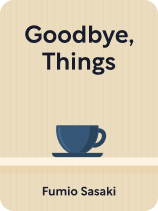

This article is an excerpt from the Shortform book guide to "Goodbye, Things" by Fumio Sasaki. Shortform has the world's best summaries and analyses of books you should be reading.
Like this article? Sign up for a free trial here.
Do you want to be a minimalist but struggle to let go of things? How can you keep yourself from buying more stuff?
In his book Goodbye, Things, minimalist Fumio Sasaki shares his recommendations for transitioning into a minimalist lifestyle. He explains that minimalism isn’t just about throwing things away; rather, it’s a complete mindset shift.
Continue reading for Fumio Sasaki’s minimalism tips.
How to Let Go of Possessions
Fumio Sasaki offers a range of practical tips for embracing a minimalist lifestyle, which we’ve organized into three categories: changing your mindset, starting to discard things, and keeping yourself from acquiring new things.
Recommendation #1: Embrace a Minimalist Mindset
Fumio Sasaki’s minimalism recommendations don’t have you starting by throwing things away. Sasaki explains that before you start getting rid of things, you’ll need to change your mindset. He offers five specific shifts that will help you develop a minimalist way of thinking.
1) Understand that You Can Get Rid of Things
First, Sasaki recommends letting go of the idea that you can’t get rid of things. You may believe that you’re personally hardwired to hold onto things, and that while minimalism works for others, you could never do it yourself. While this view may be common, Sasaki argues that it isn’t true—anyone can become a minimalist if they put their mind to it.
(Shortform note: According to some psychologists, changing the way you perceive yourself may require changing the story you tell about yourself. This is because people use stories to understand themselves and others, and by evaluating and revising your personal story, you may be able to change what’s possible for you. For example, if you tell yourself a story about how your home has always been cluttered and disorganized, it may become a self-fulfilling prophecy, as you expect yourself to be incapable of organizing. However, if you tell a story focusing on other traits, like how you’re someone who values relationships and experiences more than possessions, then this new story gives you the opportunity to give minimalism a try.)
2) Recognize that Getting Rid of Things Is a Skill
Furthermore, Sasaki explains that getting rid of things is a skill, one that develops and strengthens with practice, much like learning a new language. At first it may feel awkward and challenging, but you shouldn’t let this discourage you. Understanding that it gets easier as you improve will help you to take those first challenging steps.
| The Four Stages of Competence As you develop the skill of getting rid of your possessions, you might progress through the four stages of competence. Introduced by learning expert Noel Burch in the 1970s, these stages are: Unconscious incompetence: You’re unaware of the skill and don’t realize that you need to work on developing it. Conscious incompetence: You recognize that you’re lacking this skill and are somewhat aware of what it’d take to acquire it. Conscious competence: You’re able to practice the skill, but it takes considerable effort, intention, and concentration. Unconscious competence: You get so good at the skill that it becomes second nature, requiring much less intentional effort than before. It’s important to recognize which stage you’re in because that helps determine how to advance to the next. |
3) Remember that You’re Gaining Instead of Losing
Sasaki encourages you to remember that getting rid of things adds, not subtracts, value in your life. You may find it difficult to throw out a sentimental keepsake or an item you spent a significant amount of money on. However, remember that as you get rid of your possessions, you’ll gain more clarity about your life, your mood will improve, and you’ll gain more freedom. Therefore, discarding an item is still a net positive in your life.
(Shortform note: Sasaki focuses on the ways that minimalism can benefit your individual life. In reconceptualizing your losses as gains, it may also help to reflect on how a minimalist lifestyle can help the environment as well. Some studies have found that the production of household goods is responsible for up to 60% of all carbon emissions. Much of these emissions come from the industrial processes required to harvest raw materials. So while discarding an item may be a net gain for you, committing to a less consumeristic lifestyle can be a gain for the entire planet. Furthermore, donating or recycling items instead of throwing them out can also reduce the need to produce more goods in the future.)
4) Focus on the Present
Sasaki also recommends that you focus your mind on the present moment when you prepare to get rid of things. He explains that many of your possessions are currently worthless to you, but you hold onto them because you either believe they’ll be useful in the future or because they were an investment you made in the past. By focusing on their present value, you may realize that these items actually add very little value to your daily life. You can therefore let go of them without losing anything truly essential to your life.
(Shortform note: According to humanist philosopher Sam Harris (Waking Up), focusing on the present moment does more than let you evaluate your posessions—it helps you break free from materialism’s “hedonic treadmill” that continually dangles happiness in the future like a carrot on a stick. Harris emphasizes that the present is the only moment you actually experience—the past is gone and the future is always out of reach. From this, we can infer that possessions can only have value in the present, and if they don’t, then they have no value at all.)
5) Change Your Relationship With Space
As you embrace minimalism, you’ll find your living space becoming emptier. Sasaki recommends cultivating an appreciation for empty spaces, enjoying the lack of distractions and the zen-like sense of calm it brings.
(Shortform note: In his call to appreciate empty spaces, Sasaki echoes religious traditions which use simplicity in their spiritual practices. For example, Zen Buddhism, which Sasaki cites as an influence on his view of minimalism, creates plain temples with open spaces and rock gardens known for their simple designs. These spaces are intended to free the mind of distractions, allowing for uninterrupted mindfulness and contemplation. Furthermore, in Christian monasticism, monks and nuns have traditionally lived in austere, unadorned cells to focus their minds on contemplative prayer.)
Furthermore, he recommends that you consider public spaces as part of “your space.” For example, instead of stocking up on personal items so they’re always at hand, you can view stores as your own personal storage facility where you simply have to pay for an item before using it. Similarly, instead of keeping extra furniture or cooking supplies for entertaining guests, you can take your guests out to local restaurants, movie theaters, or parks. By understanding that these spaces are part of “your space,” you can avoid the need to keep excessive supplies at home.
(Shortform note: In addition to allowing you to have fewer personal items on hand, spending more time in public spaces can improve your mental health. This is especially true if you spend time in “third spaces,” or public places where people gather outside of home or work, such as parks, coffee shops, bars, bowling alleys, and libraries. Studies have shown that spending time in third spaces supports relaxation and social connection. By considering these spaces as part of “your space,” you’ll likely feel comfortable spending more time there, thereby increasing your sense of relaxation and community.)
Recommendation #2: Start Discarding Things
Sasaki also offers a broad range of practical tips for choosing what to discard and overcoming the emotional barriers to letting go of your possessions.
1) Look For Low-Hanging Fruit
First, Sasaki advises beginning your minimalist journey by going for the easiest items to throw away. Start with items that are obviously junk: things that are broken, expired, or serve no purpose but have somehow remained in your possession.
Next, look for duplicate items. A single high-quality version of something is usually more valuable than several mediocre versions of the same item. For example, you probably don’t need more than one set of measuring spoons in your drawer.
Furthermore, when looking for items to let go of, Sasaki recommends that you start with items tucked away in storage spaces such as closets, drawers, and boxes. He reasons that since you aren’t using most of this stuff now anyway, many of these items will be easy for you to get rid of.
(Shortform note: Some psychologists argue that beginning with small, easy wins will increase your motivation to continue. Easy wins result in quick rewards. These rewards will feel good and motivate you to keep going, and the success will make you feel more confident in your ability to complete the task—in this case, getting rid of your stuff.)
2) Choose What to Discard
When considering each object, how do you know which items are truly essential to keep? Sasaki recommends three strategies:
1. Imagine starting from scratch: He recommends a thought experiment where you imagine that all of your possessions are gone and you have to start all over again. What would you feel that you need? By visualizing an empty home and considering what you’d deliberately choose, you can identify which possessions add value to your life and which ones you’ve accumulated by default.
2. Consider whether you’d replace an item: Sasaki recommends asking yourself what you’d do if each particular item got lost. If you’d immediately go to the store and replace it, then it might be an essential item. If you wouldn’t feel a pressing need to replace it, then there’s probably no reason to hold onto it.
(Shortform note: Psychologists explain that imagining hypothetical scenarios like those Sasaki recommends can not only help you decide what to get rid of, but can help you commit to those decisions as well. When you imagine a hypothetical scenario, your brain simulates the emotions of the experience so that you’ll be able to “pre-feel” it. By “pre-feeling” that your possessions are already gone—whether you’re starting from scratch or you lost an item—you’re able to feel that you’ll be OK, and that you might not even miss the item at all. This will make it easier for you to commit to discarding those items.)
3. Consult your passion: Finally, Sasaki recommends that you keep only items that you’re enthusiastic about. Consider whether you could talk passionately about a possession to one of your friends. If the answer is no, then the item is probably a good candidate for discarding.
(Shortform note: Sasaki’s passion test is similar to the test put forward by decluttering expert Marie Kondo in The Life Changing Magic of Tidying Up. She recommends that you only hold onto items that “spark joy.” To test if an item sparks joy, she recommends that you pick it up and see how you feel. You should immediately sense your eyes lighting up, a warmth in your heart, and a smile on your face. If an item doesn’t spark this immediate reaction, she encourages you to discard it.)
Recommendation #3: Overcome Emotional Attachments
Sasaki explains that as you begin discarding items, you’ll have to confront your emotional attachments to those items (because, as we’ve discussed, you accumulate and hold onto goods primarily for emotional reasons). Sasaki offers three tips for overcoming emotional attachments to possessions:
1) Reflect on Your Emotional Attachments
Sasaki recommends taking each item you consider discarding as an opportunity for self-reflection. Ask yourself, “Why am I holding onto this? Why is it hard to get rid of?” Recall that you’re often attached to a memory or an image of yourself rather than attached to the actual thing. By reflecting on these attachments, you’ll not only learn more about yourself, but you’ll recognize when you’re holding onto something for purely emotional reasons.
(Shortform note: In The Life Changing Magic of Tidying Up, Marie Kondo extends Sasaki’s advice with tips on how to let go of something when you encounter emotional resistance. She encourages you to start by recognizing the role that this object played in your life—even objects you don’t use have given you a lesson about what you don’t need or like. If you can focus on your gratitude and see that the object’s role has been fulfilled, then you can thank the object for its part in your life and let it go on to fulfill another role.)
2) Let Go of Gifts
Sasaki notes that some of the hardest possessions to get rid of are gifts that you’ve received from others. He explains that you may feel guilty about failing to appreciate a gift from someone. However, you can overcome this by reflecting on the gifts you’ve given other people. If you knew that someone didn’t have a use for your gift and was holding onto it purely out of guilt, wouldn’t you rather they discarded the item than continue letting it clutter their home? By applying this logic to your own possessions, you’ll find it easier to let go of gifts you’re no longer using.
(Shortform note: In The Life Changing Magic of Tidying Up, Marie Kondo builds on Sasaki’s rationale for discarding gifts. She explains that the purpose of a gift is for the giver to express their affection to the recipient. Therefore, once a gift has been given, it has already served its purpose, and you no longer need to hold onto it.)
3) Take Photos of Your Possessions
Finally, if you’re having trouble getting rid of a sentimental object because of the memories attached to it, Sasaki recommends taking a picture of the object before throwing it out. This way, you can revisit your memory any time you want to without letting the object clutter your home.
(Shortform note: Sasaki’s method of taking photos could leave you with a vast photo archive of images you never look at. In a parallel to physical decluttering, some minimalists advocate for digital decluttering, a practice of applying minimalist principles to your personal computer or digital workspace. They argue that a messy computer full of disorganized files can cause stress and lower your concentration just like a messy house full of possessions. Therefore, they recommend going through your files and deleting ones that you no longer use.)
Recommendation #4: Keep Yourself From Acquiring New Things
Even after you discard most of your possessions, maintaining a minimalist lifestyle requires that you avoid acquiring new unnecessary possessions. Sasaki offers two tips to avoid accumulating new possessions in the future:
1) Eliminate Something Old Whenever You Acquire Something New
First, Sasaki recommends adopting a personal rule: every time you acquire a new item, you must also discard something that you already have. This may be challenging to keep up, but it will force you to think carefully about what you need and prevent you from stockpiling possessions again.
(Shortform note: Other minimalists build on Sasaki’s advice with tips to make the most use out of the “one-in, one-out” rule. They explain that this rule is most effective when making swaps of equivalent value and worth: for instance, trade one old pair of jeans for a new one instead of swapping a cracked plastic container for a set of wine glasses. They also recommend that you use this rule to swap disposable items for more durable items. For example, you can trade that cracked plastic container for a high-quality glass container that will last much longer.)
2) Don’t Obtain Something Simply Because It’s a Good Deal
Finally, Sasaki advises you to resist the temptation of bargains and freebies. You might be tempted to make a purchase because it seems like you’re getting a good deal. This is especially true of free items such as promotions, prizes, or items that others are trying to get rid of. Sasaki cautions that free items are never actually free; their true cost is the space they take up in your home.
| How Marketers Use “Bargains” to Manipulate You In trying to resist bargains, it may help to understand the ways that marketers use the allure of bargains to manipulate customers into believing they’re getting more value than they really are. These strategies typically rely on a customer’s tendency to make “relative comparisons” (such as how one price stacks up to another). Here, we’ll explore three common strategies that marketers use to make customers feel like they’re getting a bargain: Anchoring: The marketer presents an “original price” that’s higher than the actual price. The customer believes the price has dropped and thinks they’re getting a good deal, even though the “discount price” is what the marketer planned on selling the product for in the first place. That’s not all: Common in informercials, a marketer will tack on an additional product or benefit before the customer has a chance to make a decision. This makes the customer feel like they are getting more value because they’re comparing the current offer to the initial offer. Decoy pricing: When comparing two offers, a marketer will introduce a third offer at a higher price so that the middle price option looks like a better value. For example, a seafood restaurant that adds a really expensive menu item might see an increase in sales of its second-most expensive item, which now looks affordable in comparison. |

———End of Preview———
Like what you just read? Read the rest of the world's best book summary and analysis of Fumio Sasaki's "Goodbye, Things" at Shortform.
Here's what you'll find in our full Goodbye, Things summary:
- Fumio Sasaki's story of how he threw away his belongings and found happiness
- Why minimalism is more than just an organizational strategy
- How to keep yourself from acquiring new things to maintain your lifestyle






